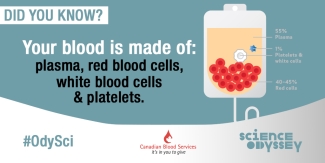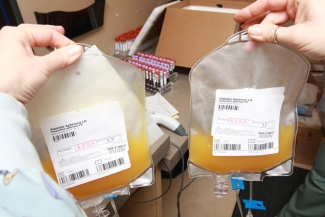It's Science Odyssey Week in Canada from May 12 to 21. Enjoy 10 days of discovery and innovation across the country. Find out where activities are taking place near you.
In the spirit of Science Odyssey 2017 we worked out a little hands-on experiment to try at home or in class. Ever wonder why your blood is red? Want to get a "feel" for what your blood would look like up close? Try this...
Ingredients
1/2 cup corn syrup (PLASMA)
1/2 cup red jelly beans (RED BLOOD CELLS)
1 tbsp. dry white lima beans (WHITE BLOOD CELLS)
10 lentils (PLATELETS)
Directions: Mix together in glass jar or bowl. Voila!
Quick facts:

Blood is red because of the red blood cells. They look like tiny doughnuts without holes and the red colour comes from the combination of oxygen and hemoglobin, which is an iron-containing protein that carries oxygen. The average person has about 25,000,000,000,000 (25 trillion) red blood cells. Red blood cells carry oxygen to the tissues and organs and pick up carbon dioxide and carry it back to the lungs for removal.
Plasma is straw-coloured and makes up more than half of our blood. Plasma carries the red blood cells, white blood cells, and platelets through our bodies, like a cell transportation system. Ninety per cent of plasma is water, while the other ten per cent is made up of things like proteins, minerals, vitamins, sugars, fats, and other materials that fight disease and act as chemical messengers.
Platelets are small, delicate and oddly shaped. When we get a cut or scratch that bleeds, it means that a blood vessel has been cut or broken. Platelets dive into wounds and bind together, getting sticky like glue. They form a seal to help stop bleeding and keep germs and bacteria out of the cut.
White blood cells help fight germs and infections. They surround the germs or bacteria like the kind you would have in a cut, a scraped knee or an infected ear, and destroy it. Because a donor’s white blood cells may suppress the recipient's immune system by interacting with it, white blood cells are removed from blood donations through a process called leukoreduction.
When we manufacture blood, we separate it into its different parts to help different patients.
Red blood cells are used in emergencies, during surgery and to help people who are in cancer treatment. Platelets are used to treat people with bleeding disorders and cancer patients. Plasma is used to treat people undergoing extensive surgery, trauma patients, and patients with liver failure.
Learn more:
Canadian Blood Services – Driving world-class innovation
Through discovery, development and applied research, Canadian Blood Services drives world-class innovation in blood transfusion, cellular therapy and transplantation—bringing clarity and insight to an increasingly complex healthcare future. Our dedicated research team and extended network of partners engage in exploratory and applied research to create new knowledge, inform and enhance best practices, contribute to the development of new services and technologies, and build capacity through training and collaboration.
The opinions reflected in this post are those of the author and do not necessarily reflect the opinions of Canadian Blood Services nor do they reflect the views of Health Canada or any other funding agency.
Related blog posts
Ten days of discovery Science Odyssey is a 10-day collaborative event geared to engage and inspire Canadians of all ages with science, technology and engineering and mathematics. It brings together a series of fun activities across the country from Friday, May 6 to Sunday, May 15, 2016. In...
Blood is red. That’s because of the red blood cells or erythrocytes that whizz around your veins and arteries. The colour is a great visual marker, both clinically and emotionally, but sometimes its very redness hides the other important components that are in you to give. These include plasma, the...

